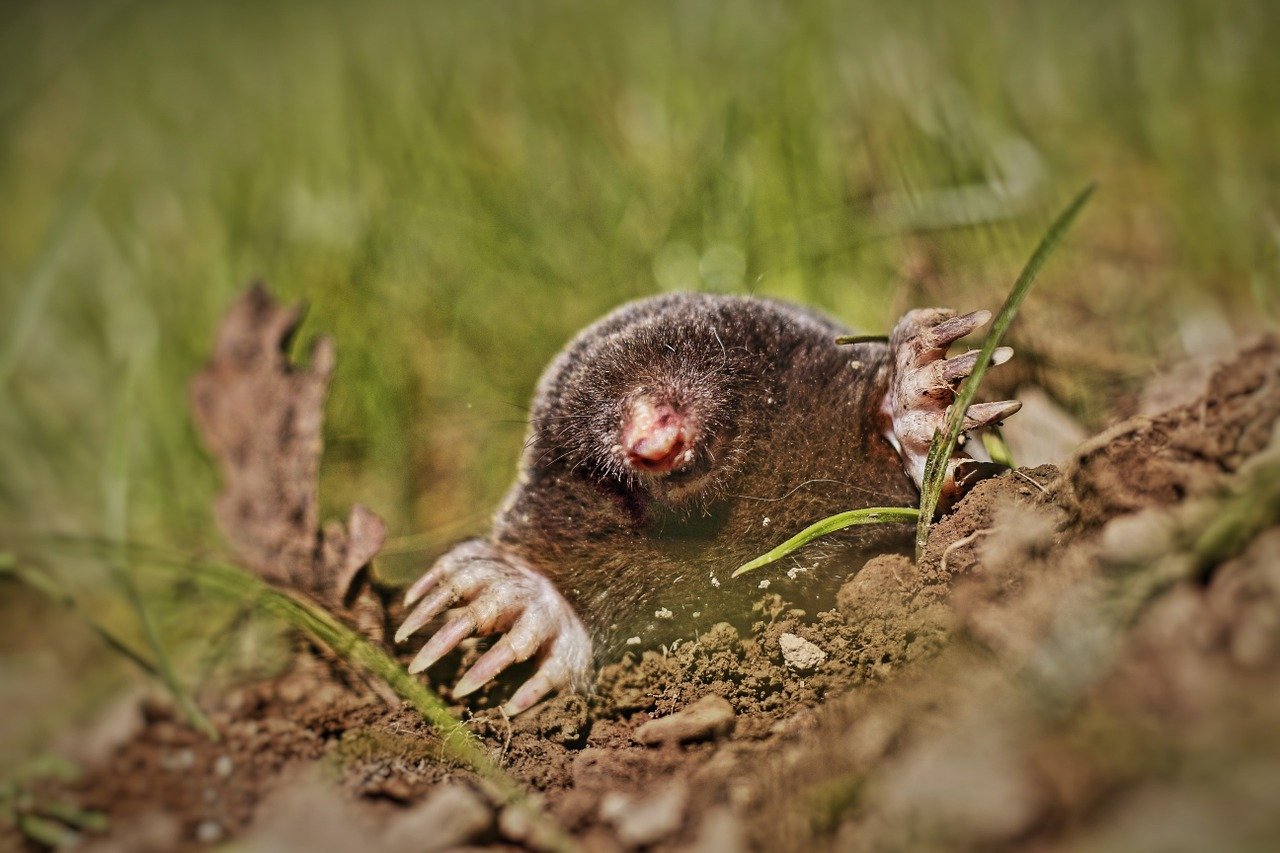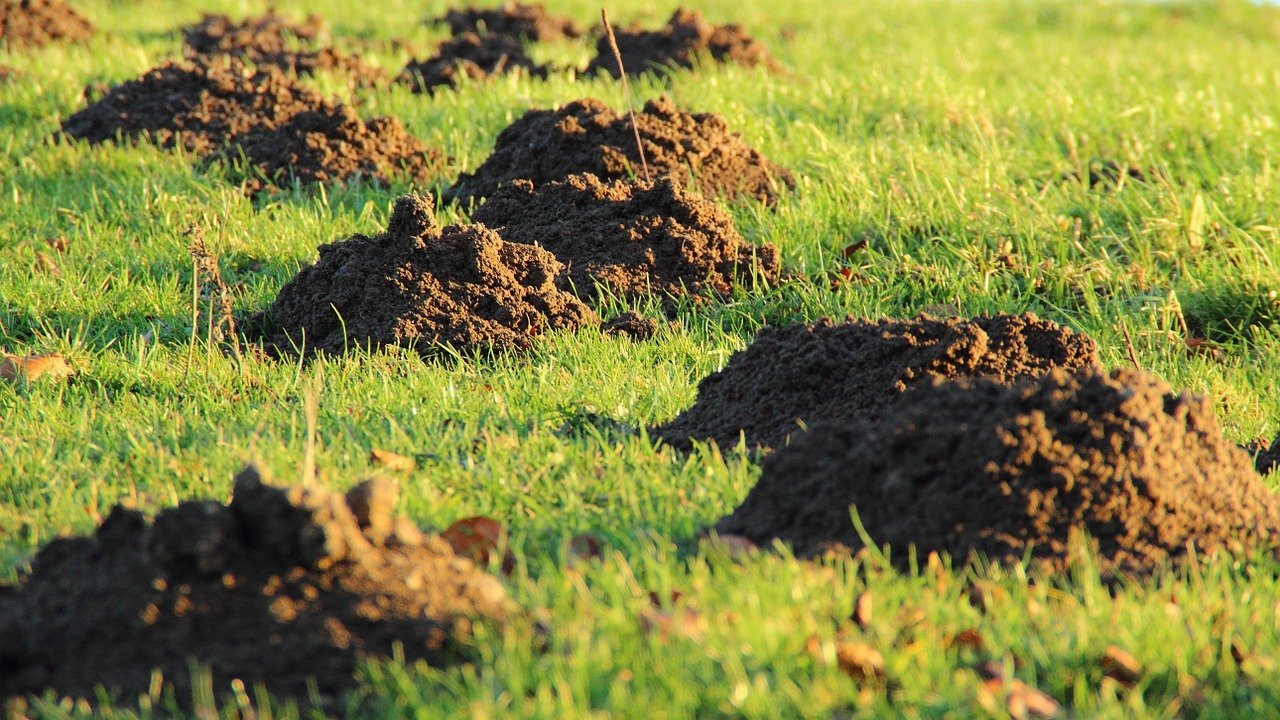Mole Control & Removing Them From A Yard

Moles are unique creatures that spend their lives underground, constantly digging under the earth’s surface to hunt and navigate. Notoriously, their digging habits destroy lawns, gardens, and golf courses, frustrating owners of homes and businesses.
Mole activity is a frequent issue for homeowners because of the intricate root systems they create. Getting to know the species will make it easier to get rid of moles.
What Does A Mole Look Like?
Moles have a hairless, pointed snout that extends nearly 1⁄2 inch in front of the mouth, and the length of the body is about 5 to 7 inches.
The body of the mole has adapted over time for underground life. Their tiny eyes and their ears’ openings are covered in their fur (to keep dirt out), and their ears don’t protrude out.
Their paddle-like forefeet are very wide and long, with prominent claws that allow the animal to dig quickly. With slender, sharp claws, the hind feet are small and narrow.
Mole fur is short, smooth, velvety, and provides little resistance in either direction when brushed. This adaptation helps moles to move through the soil both forward and backward. 1Go To Source extension.psu.edu -“Moles”
North American Mole Species
Where Can Moles Be Found?
 Moles live on every continent, except for Antarctica and South America. The mole species requires soil rich with insects to survive.
Moles live on every continent, except for Antarctica and South America. The mole species requires soil rich with insects to survive.
They live in grass fields, urban areas, gardens, sand dunes, mixed forests, or in any location with soil to dig tunnels. They tend to stay away from acidic soil regions and mountain areas.
As the urbanization of rural areas continues, people are getting closer and closer to the mole’s habitat. It’s become common for moles to be seen around people populated areas. The moles will live around gardens in hopes of getting a quick meal from planted seeds or roots. Many homeowners turn to mole removal services to take back control of their gardens.
What Do Tunneling Moles Eat?
Moles are insectivores that tend to eat insects that live below the ground. As the animal tunnels through the ground, it will eat almost every insect it comes across.
During the warmer months, the moles tunnel closer to the surface and eat roots/seeds of plants. It is common to have a garden raided by a hungry mole population.2Go To Source in.gov -“Eastern Mole”
Top 10 Prey Of The Mole
- centipedes
- earthworms
- sowbugs
- beetles
- slugs
- crickets
- ants
- snails
- termites
- spiders
Lawn Damage Courtesy Of The Mole
 The mole has established itself as a pest in yards across the U.S., with a habit of burrowing and creating unsightly tunnels that damage roots and weaken the lawn surface.
The mole has established itself as a pest in yards across the U.S., with a habit of burrowing and creating unsightly tunnels that damage roots and weaken the lawn surface.
Once a mole invades a yard, it can almost immediately cause significant damage, especially when it’s in pursuit of prey. The average mole can burrow through 18 feet of soil in one hour.
Keeping an eye out for mole damage on a property can potentially save the homeowner time and money on repairs.
4 Common Signs Of Mole Damage
Keep an eye out for evidence of moles and the infestation can be curbed before your lawn is completely destroyed. Common signs of moles on a property include:
- Volcano-shaped mounds of soil are pushed up from deep below the soil surface with no entrance or exit holes
- An elevated linear ridge of soil that runs through lawn grass, eventually becoming a complex network of lines entering and exiting the yard
- In the shaded portions of lawns, mounds, and ridges of dirt
- The soil appears soft and spongy around ridges and mounds3Go To Source naturalresources.extension.iastate.edu -“Moles: Damage Management”
Mole Prevention Strategies
Searching for a food supply is the main reason that moles invade your yard. Earthworms, grubs, and lawn insects are their primary food sources. They won’t find your yard attractive if no food is available. Take the necessary steps to rid your lawn of insects and leave no reason for moles to come around.
Over-watered lawns are attractive to moles. Moles like soft, damp earth because it allows for easy tunneling.
Avoid over-watering your lawn and keep it on the dry side to limit mole and earthworm activity. Remember: to stay healthy, most lawns need only 1 inch of water per week from either an irrigation system or rain.
Mole Trapping & Removal
Trapping is a difficult and tedious process better left to professionals, given the elusive nature of moles. Tunnels created by the moles are large with many routes to escape. The various escape options make it difficult to pinpoint where exactly a mole is hiding.
Many home remedies/repellents for mole animal removal can be found online, but most are inhumane or inefficient. Just like any other wildlife species, moles should be removed humanely.
Traps and removal products are widely available to the public, but an inexperienced person conducting the removal may never catch a mole. The cost of mole trapping only increases when homeowners buy ineffective traps. Mole animal removal experts have the proper training and experience to quickly eradicate a mole infestation. A mole control service will take strategic steps based on mole activity to ensure any mole infestation can be completely eliminated.
Sources:
- Brittingham, M. (2020, November 22). Moles. Retrieved December 04, 2020, from https://extension.psu.edu/moles
- Indiana Department Of Natural Resources. (n.d.). Header. Retrieved December 04, 2020, from https://www.in.gov/dnr/fishwild/5740.htm
- Johnson, K., & Pease, J. (n.d.). Moles: Damage Management. Retrieved December 04, 2020, from https://naturalresources.extension.iastate.edu/encyclopedia/moles-damage-management
